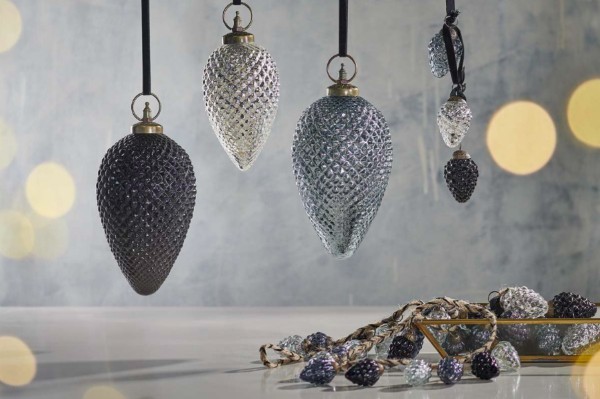
When David Attenborough was asked about the one thing we can do to help protect the planet, his message was clear – ‘stop waste of any kind’. In spite of the shocking statistics we hear about excessive waste over the festive period, consumers are increasingly willing to change their ways, and spend more on sustainable alternatives. This year, many of us will be making the switch to more eco friendly Christmas decor, gifts, food and traditions.
Tinsel and baubles, along with gift wrap, cards and crackers that have foil, glitter and shiny elements, are usually made of non-recyclable plastic. Some businesses however, are taking action. Marks and Spencer for example, have now banned glitter from all their Christmas cards and gift wrap.
Thankfully when it comes to decor, there are some beautiful natural, recyclable and low waste options – that won’t deprive you of sparkle and shine – and have a reduced environmental cost. Read on for our 9 steps towards greener Christmas decorating.
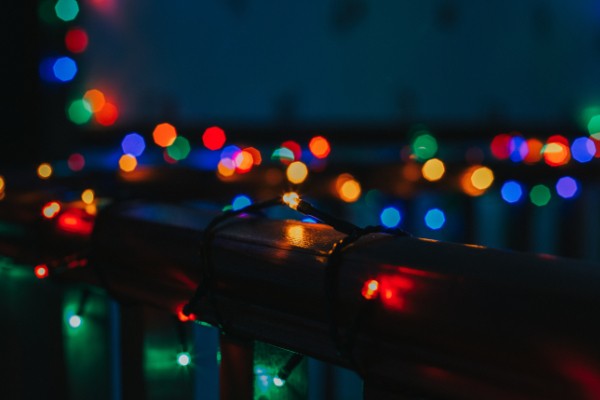
Sustainable Christmas Trees
Your first step towards eco friendly Christmas decor is navigating the hotly debated ‘real vs fake’ Christmas tree. You might believe that Christmas just isn’t Christmas without a real tree. But this obsession is costing us. In 2014, it was reported that in the UK 160,000 tonnes of Christmas trees were dumped instead of recycled, meaning they went straight to landfill.
At the end of 2016, The Local Government Association estimated that the UK taxpayer pays nearly £100 per 40 Christmas trees that are sent to landfill. But it gets worse. Because trees are left to rot, they give out harmful methane gas, which is very bad news for the environment.

In spite of this, The Carbon Trust affirms that real trees are still better for the environment than fake trees, as you would need 10 years usage out of your fake tree to have lower carbon emissions than its real counterpart. Buying a second hand artificial tree however, will of course extend its life span.
The Carbon Trust says the best option is buying a potted Christmas tree with its roots, so that it can be replanted, kept alive and used year after year. But, they can grow very large. The RHS offers some good guidance on this, and says ‘the smallest growing Christmas trees are probably Fraser firs, which reach about 7m (23ft) after twenty years.’
If you don’t have space to replant your tree, you can also rent a Christmas tree which means someone else will plant it for you, after use. And if that’s not possible, you should do one of the following:
- Drop your tree off at a recycling centre where it can be chipped for walk paths or turned into soil.
- Check out your local council’s website to see if there’s a special collection service.
- Find an organisation or a charity that offers a treecycling service where it could be used to make effective barriers against floods.
- Safely cut up and burn your Christmas tree on a bonfire.

Lastly, look for trees that have the FSC label (Forest Stewardship Council) or BCTGA label (British Christmas Tree Growers Association). The BCTGA’s list of plantations will tell you where to source a sustainably farmed British tree.
❄︎
Handcrafted and locally made Christmas decor

A reduction in carbon footprint can be made by shopping for handmade decor locally from independent makers. This brass moon topper is by UK designer-maker Nadine Hadden.
❄︎
Heirloom Christmas decorations

You could say the most eco friendly Christmas decor pieces are the ones we consider ‘timeless’ – the heirloom decorations you love to bring out year after year. Forge Creative are a Sussex based studio specialising in bespoke handmade furniture and objects made from wood and built to last. These one-of-a-kind tree ornaments are made from wooden offcuts. They start at £16 and can be bought from The Arboretum.
❄︎
Natural wax candles
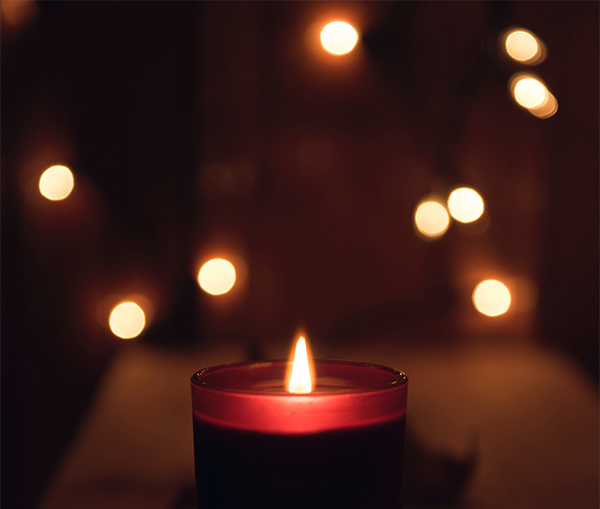
The Little Book of Hygge reveals that 28% of Danes light candles every single day of the year and more than 50% almost every day during autumn and winter. With so much candle burning going on, the less toxic they are, the better.
Standard candles are often made from paraffin wax, a byproduct of petroleum. Natural wax, on the other hand, such as soy wax, rapeseed wax, beeswax or coconut wax, is not only a renewable resource, it provides a much cleaner and longer lasting burn.
‘100% natural’ may mean non-toxic, but it does not always equate to ‘more sustainable’ in its manufacturing – if only it were that simple. There are lots of issues around deforestation in the production of soy for example.
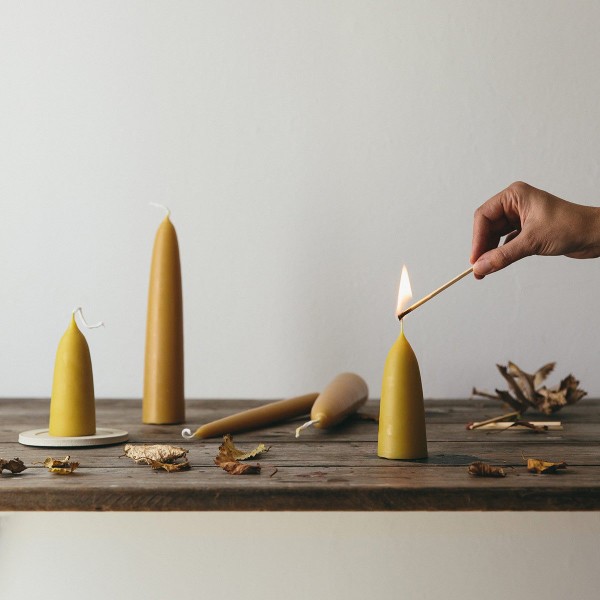
Candles made from sustainably made beeswax and bought from a local producer will allow for good traceability. Brookfield Farm candles are hand dipped and poured from pure natural beeswax direct from farm hives located off the shores of Lough Derg in Co. Tipperary, Ireland. Online store The Future Kept also sell candles made from 100% English sustainably sourced beeswax candles (pictured above).
❄︎
Glass decorations
Achieve sparkle with glass and light rather than glitter. Nkuku’s baubles* are handmade from recycled glass by artisans in India. These glass Harini baubles start at £14.95 for a set of 4. Read more about Nkuku’s environmental and fair trade practices here.
❄︎
Recyclable decorations
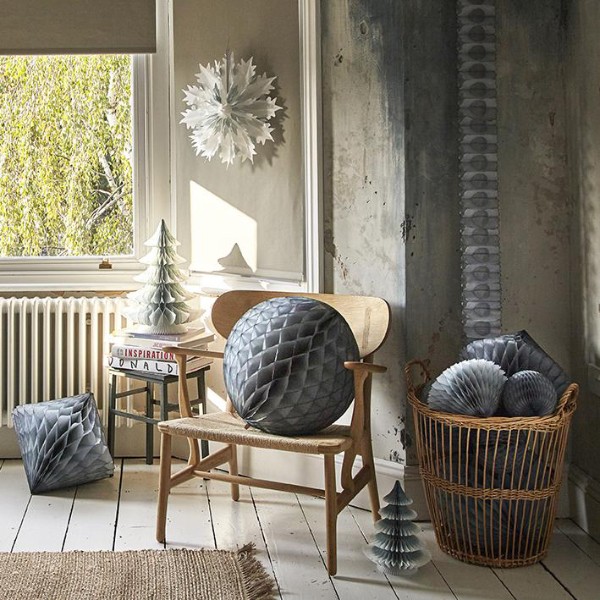
Sustainably manufactured paper decorations are another eco alternative to plastic. Snowflake decorations by Paper Dreams are made in Europe from FSC paper. They are designed to be reused and stored flat. The product and packaging can also be recycled after final use. As well as offsetting their carbon emissions, Paper Dreams plant a tree for every online order.
❄︎
LED fairy lights

During the festive period, houses draped in twinkling lights mean some cities are 20-50% brighter than usual. NASA can even see it from space.
Choose LEDs over incandescent. According to the Energy Saving Trust, if you replace all the bulbs in your home with LED lights, you could reduce your carbon dioxide emissions by up to 65kg a year. This is equivalent to the carbon dioxide emitted when driving your car around 220 miles.
An additional energy saving tip – use solar powered lights with a self-timer* so that you can cap their energy usage.
❄︎
Natural Christmas decorations
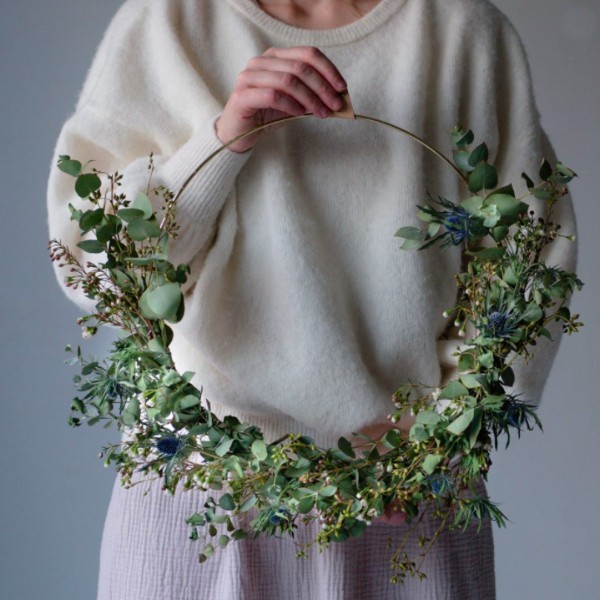
Achieve more eco friendly Christmas decor with locally sourced natural foliage that can be dried or composted. You’ll have the added bonus of not having to store them once Christmas is over.
An easy DIY wreath can be achieved with a Strups brass ring (available from Skandivis). The results are chic and contemporary, perfect for the minimalist Scandi inspired interior. See plenty of inspiration on the Strups Instagram page. This wreath was created by Berlin stylist and photographer Anna Cor.
Along with foraged natural branches from which you can hang a few simple ornaments, evocative scents such as pine, cinnamon, eucalyptus, cloves, orange and ginger will hopefully induce calmer moments, away from the Christmas madness.
❄︎
Edible Christmas details
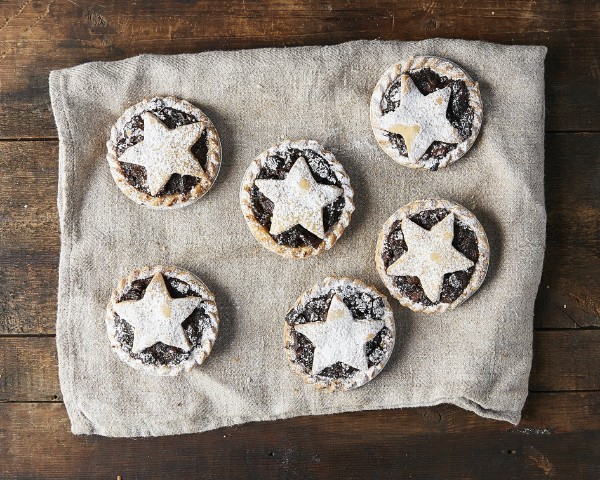
Advocates of minimalism are always looking for ways to reduce the amount of stuff they own. What better way to clear the clutter than to eat your Christmas decorations? Add seasonal touches to the table with Christmas themed biscuits and sweets.
These organic mince pies are by London-based Celtic Bakers. You can also order via Farmdrop, a grocery delivery company working with farmers and food makers who grow locally and sustainably.
❄︎
Photo credits
Images courtesy of businesses mentioned bar the following:
Featured image by Sharon McCutcheon
1st image by Georgia de Lotz
2nd image by Andy Holmes
3rd image by Andre Gorham II
4th image by Jit Kumar
7th image by Joanna Kosinska
11th image by Jari Hytönen

